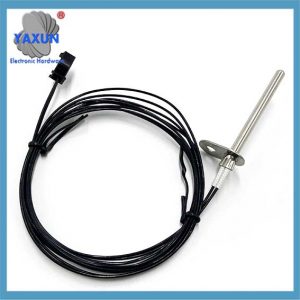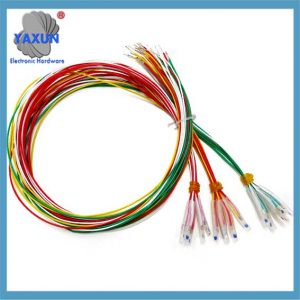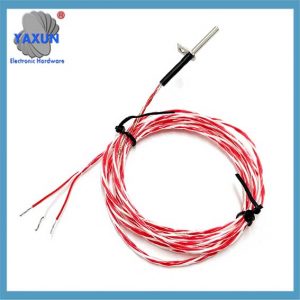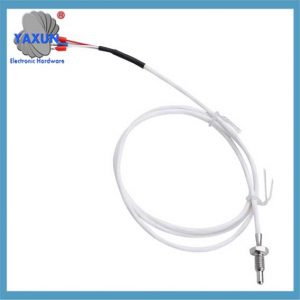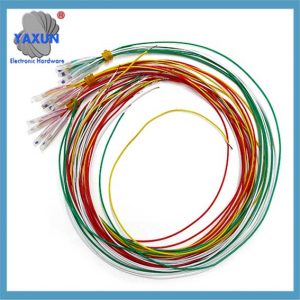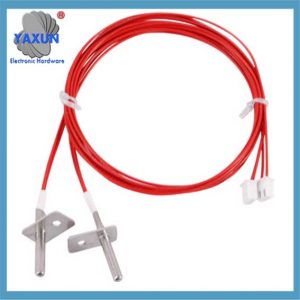Il kit sensore di temperatura EV include: Oltre ai sensori di temperatura del pacco batteria dei veicoli elettrici, sensori di temperatura del motore; sensori di temperatura dell'inverter; maniglia del caricatore, sensori di temperatura della porta e del connettore ad alta tensione; sensori di temperatura del sistema di gestione termica; sensori di temperatura della cabina; sensori di temperatura della cappa.
As a leading innovator of advanced sensing technology and innovative embedded measurement solutions, Amphenol Advanced Sensors is also a world leader in the field of new energy vehicle EV temperature sensors. They have always believed that new sensor technology has played a key role in keeping electric vehicles running at optimal performance and safely.
It is believed that as the new energy vehicle market expands, the EV automotive sensor market will also grow. Il motivo è semplice: proprio come i veicoli con motori a combustione interna, electric vehicles require high-performance and precise sensor technology to ensure performance and safety.
As with internal combustion engine vehicles, overheating can seriously affect the function and safety of electric vehicles and their service life. It can be said that automotive temperature sensors play a wider role in EVs because many of its components are more sensitive to suboptimal temperatures or perform poorly.
1. Motor Temperature Sensor
EV motors are not unlike the engines of ICE vehicles – they have many parts that work together seamlessly. More importantly, they get hot when used.
Like ICE engines, EV motors need to be kept within a certain temperature range to operate efficiently – between 90-95°C. Exceeding that range in an EV can lead to overheating, during which the engine may run inefficiently or enter a safe mode.
Install EV temperature sensors to monitor:
Motor oil temperature
Motor winding temperature
Motor coolant temperature
Motor temperature control is not strictly about lowering the temperature. In climi più freddi, the motor temperature needs to rise to around 15°C to drive in order to operate efficiently.
2. Inverter Temperature Sensor
As the gateway that converts DC to AC to power the motor, the inverter controls the lifeblood of the electric vehicle. A byproduct of the current conversion is heat, which can far exceed the 150°C temperature limit if not controlled. When exposed to excessive heat for a long time, internal components begin to fail and the device will not function properly.
Common effects of inverter overheating include:
Insulation degradation
Solder cracking
Metal warping
3. Charger handle and port temperature sensors
As the power source for the EV, the handle and charging port of the EV charger can also overheat. High temperatures indicate a number of problems:
Bad connections
Faulty charger
As fast DC charging technology advances, monitoring the temperature of the EV charging handle and its port will become increasingly important. Although fast charging technology has reduced the recharging time to 80% charge to 30 minuti, today’s consumers are looking for a refueling experience that is more like filling a tank of gas.
Fast charging requires converting a large amount of electrical energy, which generates a lot of heat. As technology improves to reduce charging time, monitoring temperature can help ensure the process is safe and efficient.
4. Thermal management system temperature sensor
While the basic function of the thermal management system is to regulate the mechanical components and battery of the electric vehicle, the system itself also needs to be monitored.
The temperature of the thermal management system directly affects the EV components it is supposed to cool. When its temperature soars beyond the normal range, a domino effect can occur, leading to many of the same problems listed previously. Fornisce informazioni critiche al controller di sistema per ottimizzare le prestazioni e ridurre al minimo il consumo di energia mantenendo le temperature del sistema adeguate con i sensori di temperatura che monitorano i punti chiave nei sistemi di refrigerante e refrigerante.
Le alte temperature all'interno del sistema di gestione termica sono un segno sicuro che qualcosa non va, se si tratta di un errore all'interno del sistema – come una perdita – o un difetto in uno dei componenti si sta raffreddando.
5. Sensore di temperatura della cabina
Un veicolo troppo caldo o troppo freddo può portare a un giro scomodo per molto tempo. A parte il motore, Il sistema HVAC di un veicolo elettrico è la caratteristica operativa più evidente di un veicolo elettrico quando è in esecuzione.
La pietra angolare della funzionalità di un veicolo elettrico è l'efficienza – or making sure it’s not using more power than is absolutely necessary. EV sensors tell the car and the computer exactly how hard the vehicle’s systems need to work.
With an in-car EV HVAC system temperature sensor, drivers and passengers can stay comfortable without draining the battery too quickly and reducing range.
6. Under the Hood Temperature Sensor
External temperature sensors aren’t meant to let drivers and passengers know what climate they’re in.
Just like the in-car HVAC temperature sensor, an external device tells the vehicle that some other system, such as the thermal management system, must work to overcome the ambient temperature. External temperature sensors are typically mounted under the hood of a car or truck.
Fast Charging and Electric Vehicle Sensors: Un accoppiamento necessario
Chiedi a qualsiasi autista quale sia la caratteristica più importante della propria auto o camion, E la maggior parte probabilmente dirà la capacità di arrivare dal punto A al punto B in sicurezza. Dopotutto, Questa è la funzione principale del veicolo.
L'ultima cosa che il proprietario del veicolo desidera è scoprire che il proprio veicolo non è pronto quando sono pronti. Un serbatoio vuoto di gas non li porterà a una riunione importante per il cliente o al torneo di calcio del loro bambino. Lo stesso vale per una batteria impoverita.
Mentre i veicoli elettrici utilizzano una fonte di carburante diversa rispetto ai tradizionali veicoli a motore a combustione interna, Ciò non ha cambiato le aspettative dei proprietari sui loro veicoli o flotte per immediati, trasporto su richiesta.
Nonostante i progressi nella tecnologia della batteria, C'è ancora la percezione che i veicoli elettrici si esauriscano il succo nel peggior momento possibile: quando i conducenti sono lontani da una stazione di ricarica. Per di più, I proprietari di auto a gas sono abituati a fare rifornimento in pochi minuti. Come può la ricarica del veicolo elettrico essere veloce e conveniente come lo è ora?
Combinato con fonti di potenza mobile più durature, La tecnologia dei veicoli elettrici a carico rapido potrebbe risolvere questi problemi e aiutare i veicoli elettrici a tenere il passo con auto e camion che corrono con i combustibili fossili.
Comunque, La tecnologia di ricarica rapida e l'infrastruttura della stazione di ricarica di accompagnamento non sono sufficienti per aiutare i potenziali consumatori di EV a superare le preoccupazioni del tempo per la ricarica sprecata. Per coloro che vogliono una transizione senza soluzione di continuità alla guida di un EV, I risultati pratici contano. EV sensors are essential to making charging nearly as fast as refueling at a gas station.
Fast Charging and Its Potential Impacts — EV Battery Health
As the missing puzzle piece in the early days of EV development, new fast-charging technologies have facilitated the continued electrification of transportation in part. While fast-charging systems make the switch to EVs more practical, they are unusable without proper monitoring.
Why? The primary byproduct of fast charging is heat, especially when converting electrical current from AC to DC. Heat is an EV battery pack’s worst enemy.
EV Sensors Need to Monitor Fast Charging in 3 Places
Ensure high-speed EV charging starts and stops safely and efficiently with sensor technology. Fast charging requires fast-responding sensors—primarily vehicle temperature sensors.
Without real-time monitoring that triggers the system to maintain ideal temperatures, the risk of thermal damage to EV components increases dramatically.
There are three places where electric vehicles must have temperature sensors for fast charging:
Connection Points
Thermal Management System
Inside the Battery Pack
1. Connection Points
There are two places where temperature sensors must be present at the connection point: the charging port and the charging handle.
For fast charging, many electrons need to be transferred quickly from the EV service device to the vehicle battery. This high current generates heat. High temperatures inside the charging port may indicate a poor connection between the charging handle and the EV contacts. From an efficiency perspective, a poor connection means the vehicle is not charging as fast as it should. Inoltre, high temperatures in the EV fast charger connector can also indicate that the charger is being overburdened by power demands, or is starting to malfunction.
2. Thermal Management System
Overheating within an EV’s thermal management system is an immediate sign that it is not working as intended and that its components are heating up, ad esempio:
Heat Exchangers
Cooling Plates
Coolant
Refrigerant
Insulating Oil
Excessive temperatures can also indicate that the EV cooling system is being overwhelmed by the overheating of the components they are supposed to cool.
3. Batteries
Lithium-ion batteries charge well between 45 and 60C, but can be damaged when charged at temperatures slightly above those. Quando le temperature all'interno del pacco batteria superano tale intervallo, Il veicolo può entrare in modalità di sicurezza e chiudere, o peggio, Inizia un processo di fuga termico.
Il surriscaldamento della batteria è uno degli ultimi indicatori che c'è un problema con il sistema di ricarica o di gestione termica del veicolo, o che la batteria stessa sta fallendo.
Il raffreddamento immediato è necessario per mantenere la funzionalità e la sicurezza a lungo termine della batteria.
Il futuro della ricarica rapida per i veicoli elettrici
Lo sviluppo di tecnologie a carico rapido per la gestione termica dei veicoli elettrici è tutt'altro che finito.
Utilizzo della tecnologia di ricarica rapida esistente, Ci vuole 30 minuti per ricaricare una batteria di veicoli elettrici 80 percentuale. Tuttavia, engineers are still working to make it as fast to fully charge an EV as it is to fill up an empty tank of an internal combustion engine vehicle—a process that typically takes less than 10 minuti.
The demand for ultra-fast EV charging is not entirely driven by a desire for convenience. Ground transportation companies and companies with fleets of large vehicles (semi-trailers and buses) have almost universally demanded ultra-fast charging that can get their vehicles moving in minutes.
Simply put, battery packs in larger vehicles are several times larger than those used in electric vehicles. They take longer to charge. But time spent charging means lost productivity and revenue.
Fast-response sensors that monitor thermals throughout an EV are essential to:
Getting vehicles back in service faster;
Preventing battery degradation or damage;
EV sensors and fast-charging systems: a necessary pairing.
While electrification is one of the biggest transformations in transportation history, vehicle owners and operators still expect a certain level of functionality. Fast-charging technology makes this transformation possible because it addresses a major problem head-on. EV sensors are the unsung heroes that make EV charging as calm as filling up a tank.
EV Thermal Management | Driving the Electrification Revolution
The actual power behind vehicles is changing the way we get from point A to point B. To do this, the sensor technology needed to keep vehicles operating efficiently and safely must be rugged, affidabile, and responsive.
These attributes are most important when it comes to EV thermal management. Un sottoprodotto naturale dell'uso del veicolo elettrico, surriscaldamento non mitigato in auto elettriche, camion, o qualsiasi tipo di veicolo ha il potenziale per far deragliare la rivoluzione dell'elettrificazione. I consumatori e le agenzie di protezione dei consumatori hanno ottime lunghe ricordi quando si tratta di fallimenti di sicurezza o errate caratterizzazioni.
Integrando la tecnologia dei sensori appropriata nel design del veicolo elettrico, La gestione termica EV è continua. More importantly, Le prestazioni dei veicoli elettrici sono praticamente indistinguibili dai loro predecessori alimentati a benzina lentamente.
 English
English Afrikaans
Afrikaans العربية
العربية বাংলা
বাংলা bosanski jezik
bosanski jezik Български
Български Català
Català 粤语
粤语 中文(简体)
中文(简体) 中文(漢字)
中文(漢字) Hrvatski
Hrvatski Čeština
Čeština Nederlands
Nederlands Eesti keel
Eesti keel Suomi
Suomi Français
Français Deutsch
Deutsch Ελληνικά
Ελληνικά हिन्दी; हिंदी
हिन्दी; हिंदी Magyar
Magyar Bahasa Indonesia
Bahasa Indonesia Italiano
Italiano 日本語
日本語 한국어
한국어 Latviešu valoda
Latviešu valoda Lietuvių kalba
Lietuvių kalba македонски јазик
македонски јазик Bahasa Melayu
Bahasa Melayu Norsk
Norsk پارسی
پارسی Polski
Polski Português
Português Română
Română Русский
Русский Cрпски језик
Cрпски језик Slovenčina
Slovenčina Slovenščina
Slovenščina Español
Español Svenska
Svenska ภาษาไทย
ภาษาไทย Türkçe
Türkçe Українська
Українська اردو
اردو Tiếng Việt
Tiếng Việt

